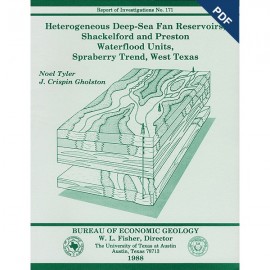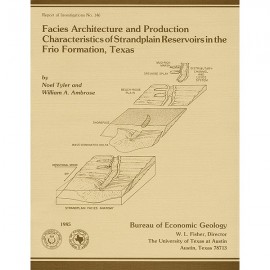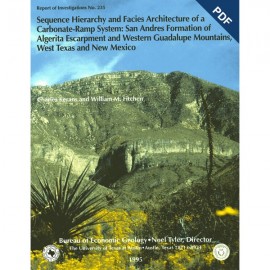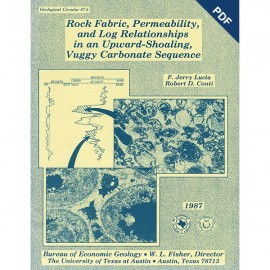Reports of Investigations
-
Books & Reports
- Reports of Investigations
- Guidebooks
- Udden Series
- Geological Circulars
- Down To Earth
- Atlases of Major Oil and Gas Reservoirs
- Texas Memorial Museum Publications
- Environmental Geologic Atlas of the Texas Coastal Zone
- Mineral Resource Circulars
- Other Reports
- Seminars and Workshops
- Handbooks
- Submerged Lands of Texas
- Symposia
- Annual Reports
- Open File Reports
-
Maps & Cross Sections
- Thematic Maps
- Miscellaneous Maps, Charts & Sections
- Geologic Atlas of Texas
- STATEMAP Project Maps
- Geologic Quadrangle Maps
- Cross Sections
- Highway Geology Map
- Energy and Mineral Resource Maps
- Shoreline Change and Other Posters
- Wilcox Group, East Texas, Geological / Hydrological Folios
- Bouguer Gravity Atlas of Texas
- River Basin Regional Studies
- Featured Maps
- Posters
- Teachers & the Public
-
Geological Society Publications
- Gulf Coast Association of Geological Societies
- Alabama Geological Society
- Austin Geological Society
- Corpus Christi Geological Society
- Houston Geological Society
- Lafayette Geological Society
- Mississippi Geological Society
- New Orleans Geological Society
- South Texas Geological Society
- GCS SEPM Publications
- Historic BEG & UT Series
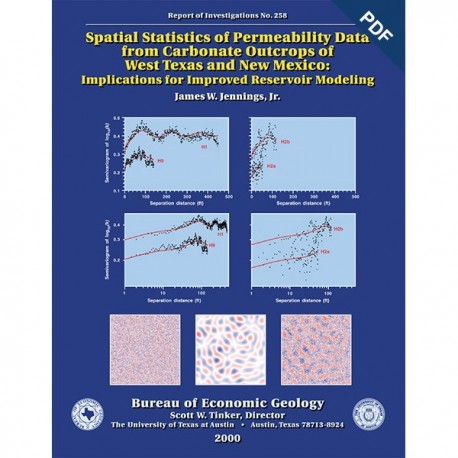
Spatial Statistics of Permeability Data...West Texas and New Mexico... Digital Download
RI0258D
For a print version: RI0258.
RI0258D. Spatial Statistics of Permeability Data from Carbonate Outcrops of West Texas and New Mexico: Implications for Improved Reservoir Modeling, by J. W. Jennings Jr. 50 p., 31 figs., 9 tables, 2 appendices, 2000. doi.org/10.23867/RI0258D. Downloadable PDF.
To purchase this publication in book format, please order RI0258.
ABSTRACT
This report presents a statistical analysis of outcrop-permeability data for quantifying spatial patterns of petrophysical heterogeneity in carbonates that are difficult or impossible to observe in the subsurface.
In the study, workers made permeability measurements using plug samples and mechanical field permeameters (MFP) from Permian and Cretaceous shallow-water platform carbonate outcrops in West Texas and New Mexico. The report includes a detailed discussion of factors affecting the accuracy of the measurements and the portability of resulting spatial statistics to subsurface studies.
The permeability data from these carbonate outcrops vary by two to five orders of magnitude, much of the variation occurring within distances of a few feet or less in single rock-fabric units. This short-range variability, present in every outcrop, composes most of the overall variance in each case. It has weak spatial correlation that can be modeled by using semivariograms having asymptotic power-law behavior at small lags.
A variety of longer range features were also observed, including (1) vertical trends within grainstone bodies, (2) vertical average permeability contrasts between grainstone bodies, (3) 140- to 180-ft lateral periodicities within high-frequency cycles, and (4) lateral trends at scales ranging from several hundred to several thousand feet in high-frequency cycles. The longer range features, composing a smaller fraction of the overall variability, may require careful analysis to detect. They can, however, have a significant effect on fluid displacement, and special attention should be given to modeling them in reservoir-performance predictions.
Keywords: carbonates, geostatistics, permeability
CONTENTS
Abstract
Introduction
Organization of the Report
Background
Contributing Outcrop Studies
Measurement Types and Methods
Statistical Analysis Methods
Semivariograms
Permeability Measurement Methods
Effects of Measurement Errors on Spatial Statistics
Hassler-Sleeve Permeability Measurements
Hassler-Sleeve-Measurement Accuracy
Plug-Size Effects
MFP Permeability Measurements
MFP-Measurement Accuracy
MFP Surface Preparation
MFP Data Averaging
Hassler Sleeve and MFP Comparison in a Carbonate Outcrop
Basic Statistical and Digital Filtering Comparison
Semivariogram Comparison
Hassler Sleeve and MFP Pros and Cons
Outcrop Exposure and Surface Weathering Effects
Lawyer Canyon Ramp-Crest Window
General Observations
Semivariogram Observations
Horizontal Semivariograms
Vertical Semivariograms
Horizontal to Vertical Semivariogram Range Anisotropy
Semivariogram Models
Lawyer Canyon Outer-Ramp Window
Plowman Ridge and West Dog Canyon
Apache Canyon
Painted Canyon
Discussion
Permeability Heterogeneity Patterns
Small-Scale spatial correlation
Longer Range Variability
Implications for Fluid-Flow Modeling and Scaleup
Summary and Conclusions
Permeability Heterogeneity Patterns
Outcrop-Permeability Measurement
Exposure Effects and Portability to the Subsurface
Acknowledgments
References
Appendix A: Digital Transect Filters
Appendix B: Monte Carlo Test for Semivariograrn Oscillations
Nomenclature
Variables
Subscripts
Figures
1. Locations of Permian outcrops having petrophysical data used in this study. Guadalupian paleogeography of West Texas and New Mexico and major Permian shallow-water platform carbonate reservoirs, including those for which outcrops are analogs
2. Location of Painted Canyon outcrop and Cretaceous paleogeography of Texas and northern Mexico
3. Illustration of stable semivariogram model for exponents in the range 0 ≤ p ≤ 2 on Cartesian and double logarithmic coordinates
4. Two-dimensional random fields simulated by using the stable semivariogram model withexponents in the range 0≤p 2 and a 5:1 anisotropy ratio illustrating the link between the power-law exponent and the strength of spatial correlation
5. Vertical semivariograms of permeability in the cycle-1 grainstone at the Lawyer Canyon ramp-crest window, illustrating the effect of data averaging in groups of as many as eight individual MFP measurements located within 1-inch2 "pads"
6. Cross plot and histograms of Hassler-sleeve and MFP permeabilities from a vertical transect of plug samples in the Lawyer Canyon outer-ramp window
7. Hassler-sleeve and MFP permeabilities from a vertical transect of plug samples in the Lawyer Canyon outer-ramp window
8. Semivariograms of unfiltered Hassler-sleeve and MFP permeabilities from the upper 60 ft of a vertical transect of plug samples in the Lawyer Canyon outer-ramp window on Cartesian and logarithmic coordinates
9. Semivariograms of unfiltered Hassler-sleeve and MFP permeabilities from the lower 150 ft of a vertical transect of plug samples in the Lawyer Canyon outer-ramp window on Cartesian and logarithmic coordinates
10. Bedding diagrams and petrophysical measurement locations for the Lawyer Canyon ramp-crest window
11. Lawyer Canyon ramp-crest horizontal MFP transects, raw measurements, and transects smoothed by means of the digital filter described in appendix A
12. Lawyer Canyon rarnp-crest vertical MFP transects in cycles 7 through 9, data from grain- dominated rock fabrics, and transects smoothed by means of the digital filter described in appendix A
13. Lawyer Canyon ramp-crest vertical MFP transects in cycle 2, raw measurements, and transects smoothed by means of the digital filter described in appendix A
14. Lawyer Canyon ramp-crest cycle-2 permeability statistics by grainstone bed number
15. Lawyer Canyon ramp-crest permeability measurements in the cycle-1 grainstone vertical transects, geometric averages grouped by depth, and 95-percent confidence intervals on the geometric averages
16. Horizontal semivariograms of permeability in the Lawyer Canyon ramp-crest window, Cartesian coordinates, logarithmic coordinates, estimated semivariograms, and models
17. Horizontal semivariograms of permeability in the Lawyer Canyon ramp-crest window, emphasizing fine-scale structure
18. Vertical semivariograms of permeability in grain-dominated rock fabrics of the Lawyer Canyon ramp-crest window, Cartesian and logarithmic coordinates
19. Comparison of horizontal and vertical semivariograms from the 1-inch and 1-ft grids in the Lawyer Canyon ramp-crest cycle-1 grainstone
20. Comparison of horizontal and vertical semivariograms from transect H1 and 31 vertical transects in the Lawyer Canyon ramp-crest cycle-1 grainstone
21. Lawyer Canyon outer-ramp horizontal-plug transects, raw measurements, and transects smoothed by means of the digital filter described in appendix A
22. Lawyer Canyon outer-ramp horizontal-permeability semivariograms Cartesian and logarithmic coordinates
23. Plowman Ridge and West Dog Canyon horizontal-permeability transects, raw measurements, and filtered transects
24. Plowman Ridge and West Dog Canyon horizontal-permeability semivariograms, Cartesian coordinates
25. Plowman Ridge and West Dog Canyon horizontal-permeability semivariograms, logarithmic coordinates
26. Apache Canyon horizontal-permeability' transect, raw measurements, and smoothed transects, making use of all the plugs, only the unfractured and nonvuggy plugs, and the digital filter described in appendix A
27. Apache Canyon horizontal-permeability semivariogram, Cartesian coordinates, logarithmic coordinates, estimated semivariogram, and smoothed semivariogram
28. Painted Canyon horizontal-permeability transect, raw measurements, and transects smoothed by means of the digital filter described in appendix A
29. Painted Canyon horizontal-permeability semivariograrn, Cartesian coordinates, and logarithmic coordinates
30. Unconditional, stochastic, vertical cross-section simulations of permeability in the cycle-1 grainstone at the Lawyer Canyon ramp-crest window, with the small-scale variability alone and with a vertical trend component in addition
31. Unconditional, stochastic, 2-D areal simulations of permeability in the cycle-1 grainstone at the Lawyer Canyon ramp-crest window with small-scale variability, an isotropic 140-ft periodicity, and both structures combined
Tables
1. Carbonate outcrops in West Texas and New Mexico whose petrophysical data are summarized in this report
2. Petrophysical data compiled in this study from carbonate outcrops in West Texas and New Mexico
3. Plug lengths and data-set sizes for significance tests of plug-size effects on porosity and permeability means and variances
4. Plug-depth categories and data-set sizes for significance tests of plug-depth effects on porosity and permeability means and variances: plug-depth A is nearest the outcrop surface; plug-depth D is farthest behind the outcrop surface
5. Comparison of porosity and permeability statistics from the Lawyer Canyon outcrop and wells 1,000 ft behind the outcrop
6. Comparison of MFP statistics from the grainstone portion of selected Lawyer Canyon ramp-crest transects and grids
7. Porosity and permeability statistics from Lawyer Canyon outer-ramp plug transects
8. Comparison of porosity and permeability statistics from horizontal-plug transects at Plowman Ridge and West Dog Canyon
9. Comparison of porosity and permeability statistics from a horizontal plug transect at Apache Canyon
Citation
Jennings, J. W., Jr., 2000, Spatial Statistics of Permeability Data from Carbonate Outcrops of West Texas and New Mexico: Implications for Improved Reservoir Modeling: The University of Texas at Austin, Bureau of Economic Geology, Report of Investigations No. 258, 50 p. doi.org/10.23867/RI0258D.

